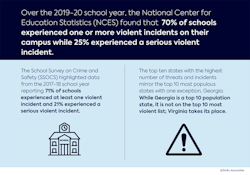The Smart Money: Evolving Tech for School Security
This article originally appeared in the January 2023 issue of Security Business magazine. When sharing, don’t forget to mention Security Business magazine on LinkedIn and @SecBusinessMag on Twitter.
Several technologies used frequently in premise security systems hold promise for school safety or protection. While they may be more common in other commercial and even residential settings, there is an opportunity for integrators to bring new and/or enhanced technologies to the school security market. Here’s a quick overview on how schools can better respond to security threats by utilizing quick-acting access control and emergency response:
PERS for Schools
A quick and precise response is vital to saving lives during a lethal school security breach. PERS sends medical requests to emergency responders from pendants or devices provided by home security or PERS providers. New solutions, like PERS devices, enable school staff to press a button to contact first responders when needed. This valuable piece of technology improves and simplifies response time, which is one of the most significant problems with active threats on campuses.These devices are a low-cost and viable solution for responding to campus threats and safety issues, which is why they are used more frequently in schools. One challenge with this technology and security systems in general, though, is false alarms. According to Parks Associates research, about half of security owners say their security system triggers too many false alarms. Additionally, 62% of home security owners report experiencing a false alarm in the past 12 months, and nearly 10% report they experienced more than five false alarms in the past year.
It is possible to accidentally press the panic button or use it for a scenario that does not require first responders. Additionally, many false alarms are triggered by user error, which can be mitigated through training, mechanical safety features, and verification like two-way voice to reduce unnecessary dispatches. AI can slow down the frequency of false alarms, primarily through video verification and video analytics.
The number of false alarms continues to grow, bringing into light how responders are coming to the scene and the actual response to the threat. According to the Educator's School Safety Network, there have been 99 false reports of school shootings, 40% more than the entire 2018-19 school year. An alternative for PERS devices is smart tags.
Location Tracking
Parks Associates consumer data shows that 37% of users use smart tags because they are concerned about another's safety, and 30% use them to keep track of another's location. Further, 32% of users say their child always has a smart tag with them. This suggests that smart tags are becoming a tool for children's safety. While they cannot send a panic message, they have precise location accuracy, which is helpful for parents to know if their child is safe.
AI-Enhanced Technology
There has been a rise in the power of AI over the past decade, which allows its implementation in critical areas such as security. Surveillance cameras are the main area where AI now appears within the security industry. Additionally, AI-based firearm detection would be highly useful in schools. Detecting a gun before it even enters the building can save lives. If the firearm is detected on the campus, a distress signal can immediately be sent to 911, demonstrating to authorities the gunman's current location and perhaps his next likely location.
In addition, understanding the number of people who have come into a building and departed is a powerful use case. This helps emergency responders understand the number of people still in the facility before, during, and after an incident. AI-enabled video cameras can do more than detect firearms; they can have situational awareness, allowing them to determine suspicious activity on the premises. It can flag this behavior, making it easier for operators to find past footage in an investigation.
AI is also appearing in auditory detection systems specifically for gunshots. These are compact pieces of hardware that are placed throughout a building. When a gunshot is fired, the receptors communicate with each other and make an educated guess of the gunshot's location and what weapon was fired. As emergency personnel is contacted, they have information on the threat at hand.
Lockdowns
Unsecured doors are a vital issue for school security breaches. The ability to lockdown a campus swiftly is essential to contain a dangerous situation.
One of many examples is Havenlock, a security technology that uses powerful locking mechanisms for school doors, including a platform that detects a shooter at a door once vibrations from gunshots going through the door or kicking against the door is sensed. The technology also allows teachers to engage locks on their classroom doors with the press of a button. A main control panel enables an operator to control all doors equipped with the technology.
In addition, automatic notifications are sent to whoever is to be notified of the threat. This technology makes access control simple and effective for schools and enables protection, detection, and notification. The added layer of access control makes any school a significantly more difficult target.
Elizabeth Parks is President and CMO of market research firm Parks Associates. For more information on the school security technologies discussed here, visit www.parksassociates.com or download the complimentary whitepaper, Leveraging Tech to Improve Safety and Security in Schools at www.parksassociates.com/whitepapers/schooltech-nov2022.
About the Author

Elizabeth Parks
Elizabeth Parks is the President of market research firm Parks Associates. For more information, visit www.parksassociates.com

